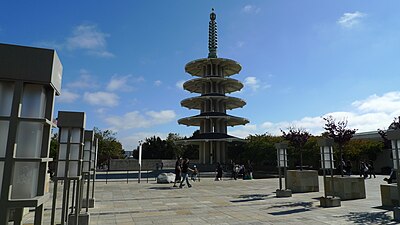|
Japan Center (San Francisco)
The Japan Center is a shopping center in the Japantown neighborhood of San Francisco, California. It opened in March 1968 and was originally called the Japanese Cultural and Trade Center.[1] It is bounded by Geary (on the south), Post (on the north), Fillmore (on the west), and Laguna (on the east). The mall itself is composed of three mall buildings; from west to east, they are the Kinokuniya Mall, Kintetsu Mall (now Japan Center West), and Miyako Mall (now Japan Center East). Anchor tenants include Books Kinokuniya and Sundance Kabuki Cinema.[2] Selected locations in Japan Center
1 AMC Kabuki 82 Books Kinokuniya3 Japan Center West (was Kintetsu Mall)4 San Francisco Peace Pagoda5 Japan Center East (was Miyako Mall)6 Hotel KabukiHistoryThe San Francisco Board of Supervisors designated what became Area A-1 of the Western Addition Project (WAP A-1), a 108-acre (44 ha) parcel, as a redevelopment project in August 1948.[3] In total, 8,000 residents were displaced from this area, which was acquired by the San Francisco Redevelopment Agency (SFRA) starting in the late 1950s under eminent domain. Western Addition Project Area A-1 included the land later used for the mall.[4]: 55–56 art of the 108 acres (44 ha) of land The Japanese Cultural and Trade Center was the first major project headed by M. Justin Herman, director of SFRA. The mall was developed by National-Braemar, who were joined by Kintetsu Enterprises Company of America (wholly owned by the Kinki Nippon Railway) in 1962. Construction of the mall began in 1965.[4]: 59 In 1966, Herman told The New York Times "We set out four or five years ago to try and crystallize and preserve the special cultural and social values of San Francisco, which in time tend to be lost and dissipated." Mayor Joseph Alioto dedicated the mall at its opening.[5] The initial tenants included the manufacturers Hitachi, Nissan, and Mitsubishi, who used their showroom spaces to demonstrate electronics and automobiles; Kikkoman International;[5] the 15-story Miyako Hotel;[6] and Books Kinokuniya. The mall was renamed Japan Center by 1970, and by the mid-70s, retailers had displaced manufacturers as consumers had become familiar with Japanese electronics and cars.[4]: 59–60 In 2009, ownership of the buildings and spaces was divided between:[5]
By 2020, 3D Investments had bought the former Kintetsu Mall and Miyako Mall, now called Japan Center West and Japan Center East respectively.[7] Due to the COVID-19 pandemic in the United States across San Francisco Bay Area in Northern California, businesses in Japan Center have been described as struggling to survive. According to a lawyer for the tenants, some had lost as much as $17,000 per month, and 3D Investments had not been forgiving to its tenants, while at Kinokuniya Inc., "no one is responding."[7] Shops and restaurantsThe Fuki-ya restaurant owned by Junko and Richard K. Diran is said to have been the first Robatayaki restaurant in the United States.[8] HotelThe hotel, anchoring the east end of the super-block, was originally constructed by the Kinki Nippon Railway and operated by the Western Hotels Company as the Miyako Hotel. The Miyako originally occupied the 15-story tower, and the 4-story building to the east of the tower, which originally housed the Consulate General of Japan, was later incorporated into the hotel property.[5] Design and featuresThe Japan Center complex occupies 5 acres (2.0 ha) of land and the construction budget was $15 million.[3] The architecture of the site, created by Minoru Yamasaki,[9] has been described as "Brutalist slabwork."[10] Van Bourg/Nakamura drafted the plans for Japan Center. It uses contemporary forms and materials and is inspired by traditional Japanese architectural features.[4]: 59 The interiors of the mall buildings were designed by Takenaka & Associates of Osaka to evoke narrow Japanese streets, as shop facades include decorative glazed tile roofs and pillars; the interiors also include large public areas with natural lighting.[5] Structural steel for the Bridge of Shops was supplied by U.S. Steel, American Bridge Division in South San Francisco, California.[11] San Francisco's Peace Pagoda is on the Japan Center site.[9] The Peace Plaza was originally designed by Japanese architect Yoshirō Taniguchi,[4]: 59 and an update in 2000 by Kenji Murokami removed a large covered walkway on the north side (connecting Japan Center West and East). The Peace Plaza was rededicated by Mayor Willie Brown in 2003.[5] Gallery
References
External linksWikimedia Commons has media related to Japan Center, San Francisco.
|
||||||||||||||||













